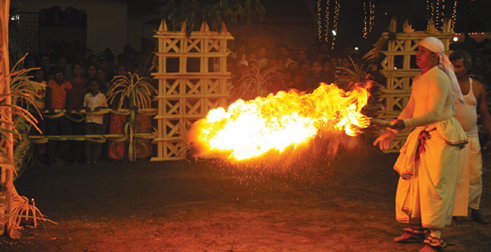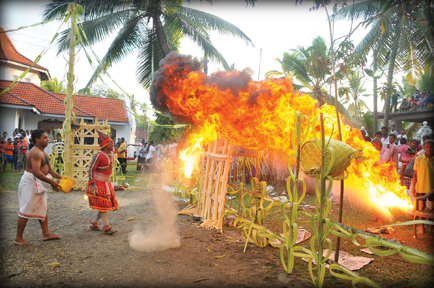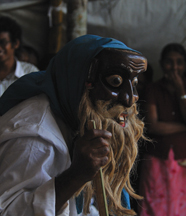|
 Gam maduwa: Gam maduwa:
An emotive ritual revisited
by Husna Inayathullah
No matter how much we’ve come to depend on modern trappings, the lure
of traditions and rituals still hold sway, perhaps reminding us of the
inner spirituality that had us beseeching the gods for blessings and
blaming the evil spirits for natural disasters, misfortunes and
sicknesses. So it comes as no surprise that a gam maduwa, a virtual
rarity in 21st century Sri Lanka, should become a mega event, attracting
a diverse crowd of enthusiastic spanning townships, cultures and
communities.
That the elaborate ritual, traditionally performed to invoke blessing
to a village and its residents, and protect them both from all kinds of
evil spirits, was held in the periphery of Colombo, was perhaps an
additional bonus, for if a gam maduwa is a rarity, a gam maduwa close to
Colombo is even more of a rarity. And it wasn’t just a gam that was held
at Sri Nandana Rama Purana Viharaya, Thalawathugoda last week, but a gam
maduwa ulela - the great hut of the village ceremony.
Traditionally, the 'maduwa' is 60 by 20 feet shed fronted by a
‘pandal’ and decorated with 'gokkola' and assorted fruit. As with all
rituals, the erection of the maduwa begins at an auspicious time, with a
solemn vow is to the gods hold the event on a date not too far off. The
central figure in the 'gam maduwa' is goddess Pattini whose symbolic
emblem is kept on a special dais in the centre with a 'mal asanaya'
where flowers are offered beseeching her blessings.
 The colourful all night event with food, fire, music and dance, is
usually performed after a bountiful harvest, with the Kapumaththaya’,
the lay head of the devale dressing up as the goddess and intoning
verses that describe her life and accomplishments. The intoning is
synchronized to the beat of the drummers whose rhythms appear to invoke
the presence of the deity as well as control the pacing of the worship. The colourful all night event with food, fire, music and dance, is
usually performed after a bountiful harvest, with the Kapumaththaya’,
the lay head of the devale dressing up as the goddess and intoning
verses that describe her life and accomplishments. The intoning is
synchronized to the beat of the drummers whose rhythms appear to invoke
the presence of the deity as well as control the pacing of the worship.
The whole township of Thalawathugoda and beyond participated in the
ceremony, striking the ancient cord of hope that the night’s rituals
would protect and bless the township and its people. A community event,
it was funded by the people who used the fresh harvest to prepare the
main meal which included a special rice and the hath malu, a delicious
curry made with seven vegetables, the first offering of which was made
to the deities in lotus leaves.
The audience was treated to a melange of traditional dances ranging
from the Thelme, Salupaliya, Vahal, Garayaka and Kalapandam, all lead by
the Kapumahaththaya, who in this instance was Lasantha Pushpakumara.
Intriguingly, the elaborate ceremony sees a high degree cross
dressing, with the men almost always taking on the role of the female
deity. The dancers or the Kapumaththaya's team of dancers descend from a
tribe devoted to Goddess Pattini, keeping the tradition alive.
The ceremony starts at around 9.00 p.m. and continues till afternoon,
the following day.
 In the beginning In the beginning
 The genesis of gam maduwa lay in the myth of
Goddess Pattini that originated in Madurapura, South India. ‘Kannagi’
was a married woman who had a great love for her husband ‘Palanga’ an
inconsiderate who did not care for his wife . He was a drunkard, but
Kannagi’s love for him never changed. The queen lost her anklet on the
day Palanga sold one of Kannagi’s anklets. The king’s guards suspecting
Palanga to be the thief arrest him while he is trying to sell Kannagi’s
anklet. The genesis of gam maduwa lay in the myth of
Goddess Pattini that originated in Madurapura, South India. ‘Kannagi’
was a married woman who had a great love for her husband ‘Palanga’ an
inconsiderate who did not care for his wife . He was a drunkard, but
Kannagi’s love for him never changed. The queen lost her anklet on the
day Palanga sold one of Kannagi’s anklets. The king’s guards suspecting
Palanga to be the thief arrest him while he is trying to sell Kannagi’s
anklet.
The king commanded that Palanga be killed.
On hearing this Kannagi became sorrowful and left in search of Palanga.
She had to cross a river, but did not have money to pay the ferryman.
She threw her ring into the river and then the water parted in the
middle allowing her entry. When she found the body of Palanga she wished
he was alive again.
She hit her other anklet to the ground and
the whole area burst into flame. Due to her power of chastity, he
regained his life tried to embrace her. But she didn’t let him and
Palanga died again in pain. Later Kannagi went to the forest and lived
in austerity. Fourteen days later and she too passed away. She took on a
divine mien and thus was born the Goddess Pattini.
In 140 AD, King Genkuttawan of Kerala , a
contemporary of King Gajaba in Sri Lanka, built a temple for Goddess
Pattini. King Gajaba participated in the opening ceremony of the temple
and thus Goddess Pattini was introduced to Sri Lanka and the Lankans
began worshipping her.
The Nawagamuwa Hindu temple is the ?rst to
be built for Goddess Pattini. Every king used to build a temple for the
Goddess in front of the castle. Other prominent Pattini Temples are at
Anuradhapura, Kandy, and Matale. When diseases like measles and chicken
pox , which are called ‘Deviyange Leda’ spread in traditional villages,
people sought the blessing of Goddess Pattini to cure these diseases.
When there was drought or famine, people
believed in Gods and ask for their help and in gratitude they performed
Gam Maduwa in a ceremonial manner. They add various cultural items such
as traditional dances, songs, dramas and instrumental music to satisfy
the Gods.
|

